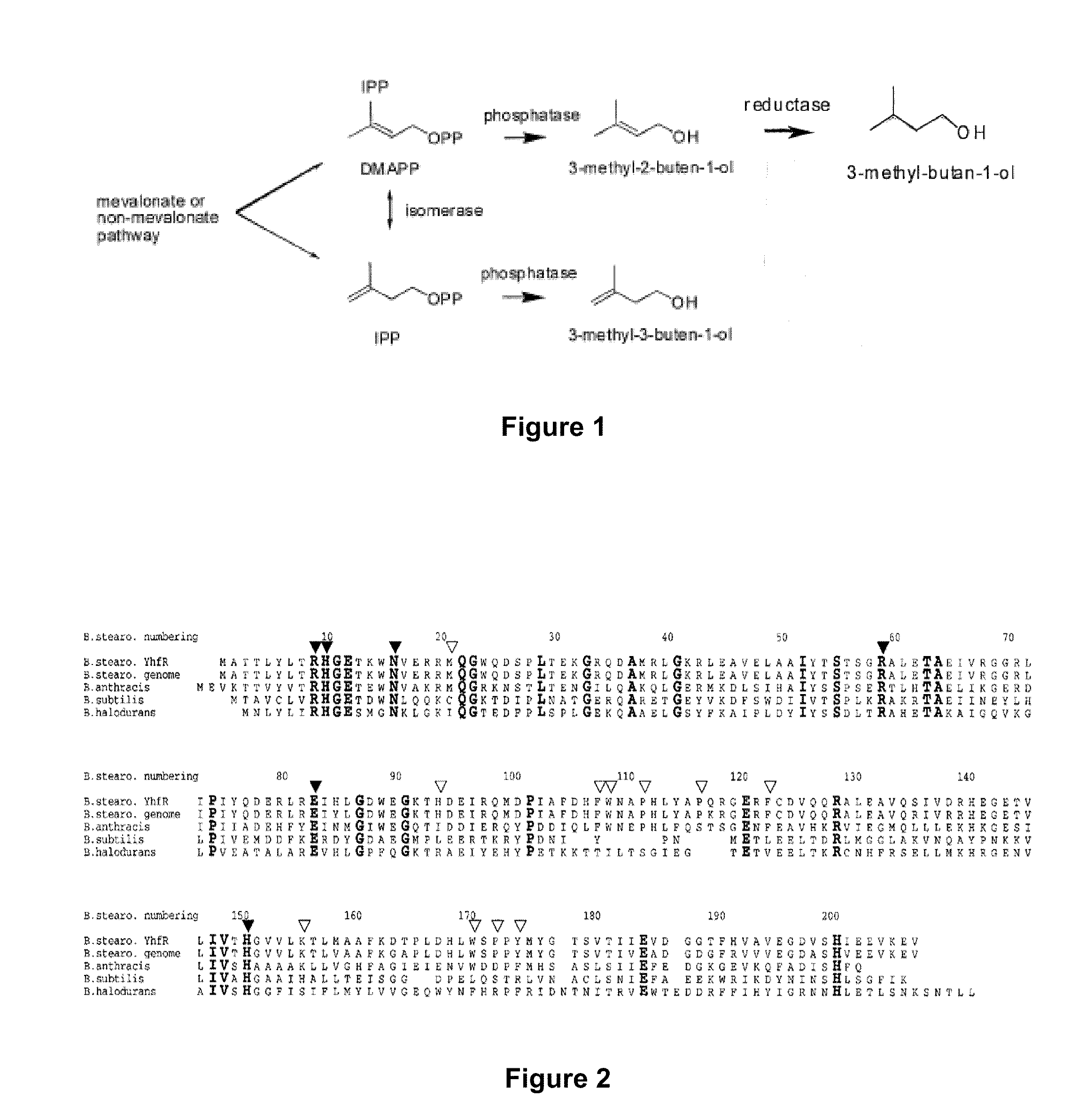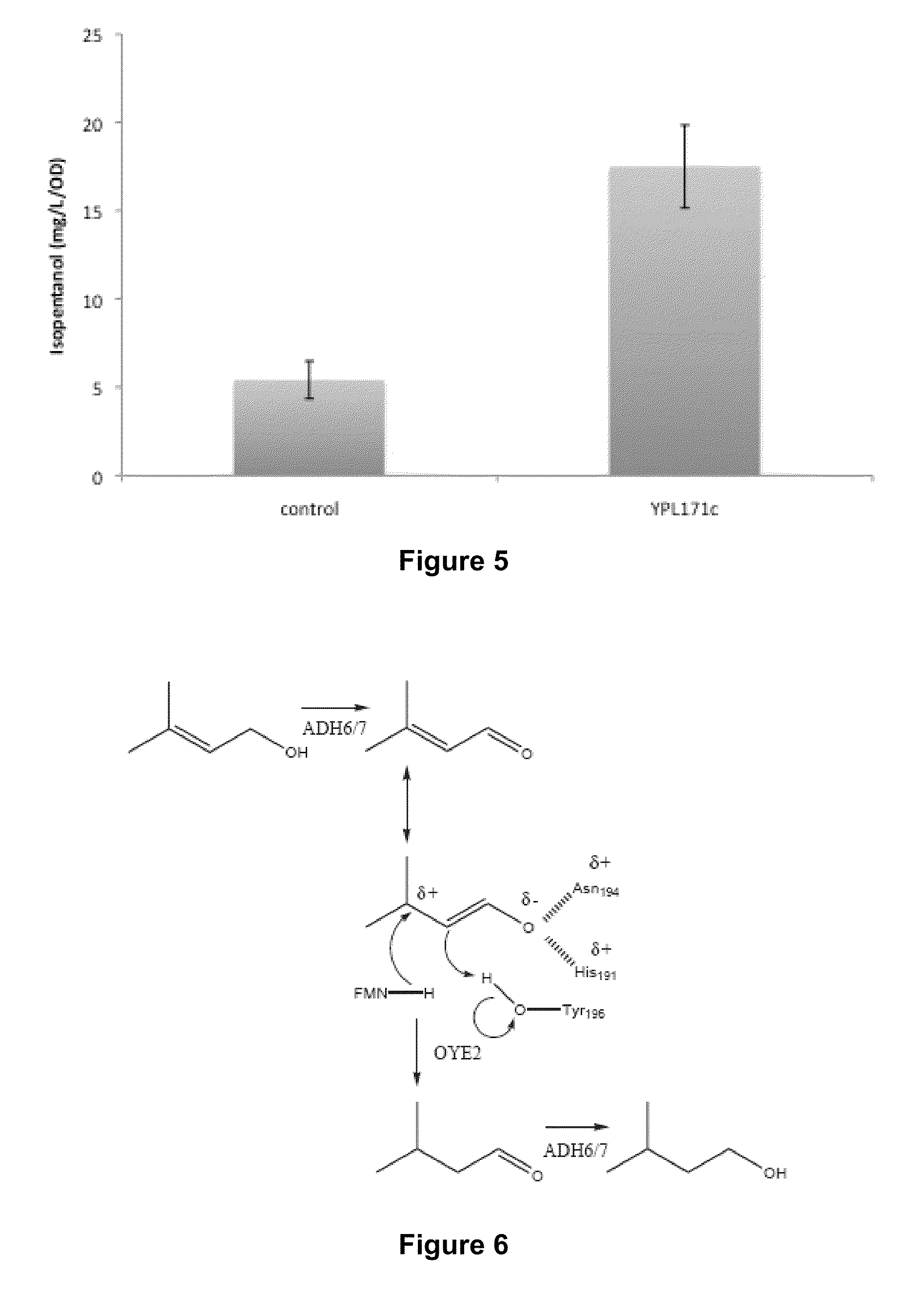Host Cells and Methods for Producing 3-Methyl-2-buten-1-ol, 3-Methyl-3-buten-1-ol, and 3-Methyl-butan-1-ol
a technology of host cells and ethanol, which is applied in the field of production of 5carbon alcohol compounds, can solve the problems of non-renewable sources of energy, debatable efficiency of ethanol as a fuel, and general unsatisfactory results
- Summary
- Abstract
- Description
- Claims
- Application Information
AI Technical Summary
Benefits of technology
Problems solved by technology
Method used
Image
Examples
example 1
Production of 3-methyl-2-buten-1-ol and 3-methyl-3-buten-1-ol in a Host Cell
[0093]The pMevT plasmid (containing the genes for synthesizing mevalonate from acetyl-CoA) and pMBI (containing the genes for synthesizing IPP and DMAPP from mevalonate) are introduced into E. coli DH10B, which then is capable of expressing IPP and DMAPP. The method for constructing the pMevT plasmid, and nucleotide sequence, are taught in U.S. Pat. No. 7,183,089, which is incorporated in its entirety by reference. The method for constructing the pMBI plasmid is taught in Martin et al. (Nature Biotechnol. 21:796-802 (2003)), which is incorporated in its entirety by reference.
[0094]Primers can be designed to PCR Bacillus subtilus phosphatase PhoE (YhfR) from Bacillus subtilus genomic DNA and cloned into a suitable E. coli expression vector. The resultant plasmid is introduced into an E. coli host cell also containing the pMevT and pMBI plasmids. The resulting transformant is cultured in a suitable medium, suc...
example 2
Production of 3-methyl-butan-1-ol in a Host Cell
[0096]Primers can be designed to PCR Saccharomyces cerevisiae fatty acid synthase from Saccharomyces cerevisiae genomic DNA and cloned into a suitable E. coli expression vector. The resultant plasmid is introduced into an E. coli host cell also containing the pMevT and pMBI plasmids, and a plasmid expressing Bacillus subtilus phosphatase YhfR. The resulting transformant is cultured in a suitable medium, such as Luria broth (LB) medium at 37° C. with the appropriate antibiotics to maintain the plasmids. The enzymes are induced using the appropriate inducers, such as IPTG or propionate, and incubated at 30° C. for 3-7 days. The induction of the enzymes results in the production of 3-methyl-butan-1-ol. The 3-methyl-butan-1-ol can be purified and analyzed using a GC-MS.
example 3
In Vivo Reduction of 3-methyl-2-butenol or 3-methyl-3-butenol to 3-methyl-butanol
[0097]To test the capability of yeast to catalyze the conversion of 3-methyl-2-butenol to isopentanol, 5 ml. of YPD medium with 2% glycerol, in a 100 ml culture tube, was inoculated with an overnight culture of freshly plated S. cerevisiae BY4741 cells to achieve a final absorbance of 0.5 at 600 nm (A600). The cultures were grown at 30° C. at 200 r.p.m. After 48 hours, either 3-methyl-2-butenol or 3-methyl-3-butenol (1 g / l) was added to the culture.
[0098]Cultures were sampled after addition of 3-methyl-2-butenol or 3-methyl-3-butenol and grown for an additional 2 days. The samples were collected by pelleting 1 ml of culture, and adding 150 μl of the supernatant to 750 μl of the extraction solvent (80:20 chloroform:methanol spiked with 50 mg l−1 of butanol internal standard). The samples were vortexed for 15 minutes and centrifuged for 2 minutes at 5000 r.c.f. 450 μl of the organic layer was removed from...
PUM
 Login to View More
Login to View More Abstract
Description
Claims
Application Information
 Login to View More
Login to View More - R&D
- Intellectual Property
- Life Sciences
- Materials
- Tech Scout
- Unparalleled Data Quality
- Higher Quality Content
- 60% Fewer Hallucinations
Browse by: Latest US Patents, China's latest patents, Technical Efficacy Thesaurus, Application Domain, Technology Topic, Popular Technical Reports.
© 2025 PatSnap. All rights reserved.Legal|Privacy policy|Modern Slavery Act Transparency Statement|Sitemap|About US| Contact US: help@patsnap.com



